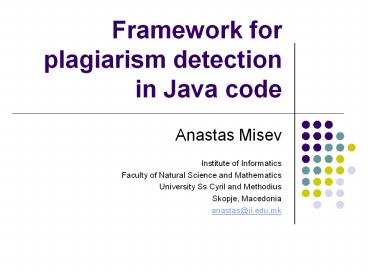Framework for plagiarism detection in Java code PowerPoint PPT Presentation
Title: Framework for plagiarism detection in Java code
1
Framework for plagiarism detection in Java code
- Anastas Misev
- Institute of Informatics
- Faculty of Natural Science and Mathematics
- University Ss Cyril and Methodius
- Skopje, Macedonia
- anastas_at_ii.edu.mk
2
Agenda
- Introduction
- Basic idea
- Open framework
- Implementation
- Future work
- Questions and discussion
3
Introduction
- Increased number of assignments according to
current trends (Bologna declaration, ) - Increased number of students
- 100 increase in our Institute in this academic
year - Accessibility of artifacts over the Internet
- Little or zero effort in plagiarism, especially
in source code
4
A few words on plagiarism
- Simple plagiarism
- Copy-paste (with some spacing and comments
modification) - Plagiarism with renaming
- Methods, fields, classes
- Reordering of the code (that does not affect the
final state) - Addition of redundant lines of code
5
A few words on plagiarism (2)
- Advanced plagiarism
- Changing of the control structures
- Mixing of several sources
- Mixing of own and others code
- Drawing the line !!!!
- It can be very hard
- Objective vs. subjective
6
Detection methods
- Attribute counting
- Used in the earliest tools
- Counting operators and operands
- Structure metrics
- Compare the structure
- Usage of tokens
7
Available tools
- Sim
- Using dynamic programming compare tokens from the
source - Yap
- Using only specific tokens that reflect the
structure - Longest common subsequence
8
Available tools (2)
- MOSS
- Available as service to the teachers over the
Internet - Important features include
- Unsceptible to spaces and tabs
- Noise suppression
- Location independency
- SID
- Simple system
9
Open framework
- An implementation done as diploma thesis by D.
Aleksovski - Java based, open framework
- Initial purpose analyze Java code
- Allows easy extension
- New analyzers
- New comparators
10
The architecture
- Two basic elements
- Analyzer
- Comparator
- Analyzer lexical and syntactical analysis of
the code - Language specific
- Produce the syntax tree and stores it into the
database - Based on ANTRL
- Comparator compare elements
- Can be used to compare code, trees, fingerprints,
11
The database
12
Operations
Comparing sources
Module
System
- If the database contains Fingerprint for file 1,
go to 4 - Call computeFingerprint (file1)
- Store the fingerprint f1 into the database
- If the database contains Fingerprint for file2,
go to 7 - Call computeFingerprint (file2)
- Store the fingerprint f2 into the database
- Forward the fingerprints to the comparator
- Call computeSimilarity(f1, f2)
- Store the values into the database
database
13
Extensions
- Two different modules developed to test the
framework - Simple module, basic features
- Can only detect basic plagiarism
- Compares the structure of the syntax tree
- Advanced module
- Produces a fingerprint of the syntax tree
- Measures the longest common subsequence of the
two fingerprints
14
Screen shots
15
Screen shots (2)
16
Initial results
17
Future work
- Support for additional languages
- New and advanced comparators and analyzers
- Web and web service interfaces
- Integration into
- Moodle
- Eclipse

